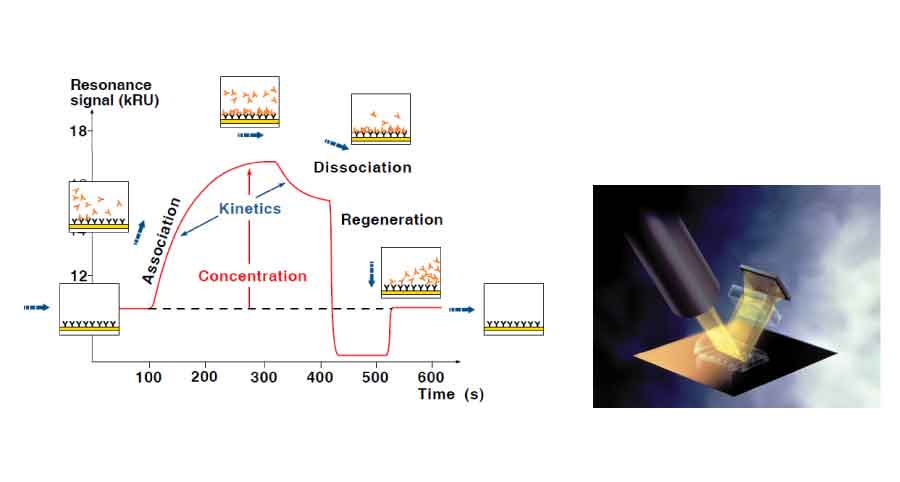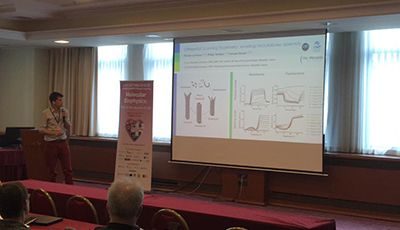
The INteractome Timone Platform (PINT) offers unique expertise in thermodynamic and kinetic analysis of molecular interactions.
PINT is equipped with microcalorimeters (ITC and DSC), nanoDSF, spectrophotometers and an Analytical Ultracentrifuge (UCA), and an optical biosensor based on surface plasmon resonance (SPR).
These techniques all aim to characterize molecular interactions (proteins, nucleic acids, sugars, lipids, small molecules, peptides, proteoliposomes, viral particles, etc...). They have in common the absence of the use of marked reagents, simplicity and speed of implementation. The complementarity of these techniques is widely referenced for the characterization of protein-ligand interactions
This platform is open to the academic and industrial research community.
The PINT platform is located on the 3rd floor of the green wing of the Faculty of Medicine
Microcalorimetry Pole
P.I. : Philipp TSVETKOV, François DEVRED
Equipment available: 3 microcalorimeters: ITC200, VP-ITC and VP-DSC allowing both isothermal titration calorimetry (ITC) and temperature scanning calorimetry (DSC) studies to be conducted, as well as the NT.Plex and Tycho nanoDSF.
The ITC makes it possible to characterize intermolecular interactions by obtaining their complete thermodynamic profile: affinity constant, stoichiometry, enthalpy and entropy.
The DSC and the nanoDSF make it possible to determine the thermostability (5-120 °C) of proteins, DNA, micelles... which gives indications on the tertiary structure of molecules and molecular interactions. The nanoDSF through the use of capillaries can also be used for quality control and to screen interactions.
In parallel with our service activity, we are conducting an R&D activity aimed at developing a new diagnostic method by calorimetric profiling of biofluids. In collaboration with INP Team 8 and the Timone Neuro-oncology Department (AP-HM) we are working on the development of a method for monitoring glioblastoma (Tsvetkov et al Oncotarget 2018). In partnership with the QARMA team of the Laboratoire Informatique et Systemes of Aix Marseille University and the company EURANOVA, both specialists in machine learning, we are developing a universal approach aimed at extending this method to other diseases of the nervous system (Alzheimer's, Parkinson's, multiple sclerosis, etc.).
Ultracentrifugation analytique Pole
P.I. : Pascale BARBIER
Equipment available : Beckman XLA Analytical Ultracentrifuge
Analytical UltraCentrifugation (UCA) allows the study of the behaviour of native macromolecules subjected to centrifugal force in solution. With the help of a detection system that measures the macromolecule concentration as a function of the centrifugation radius, we can perform two types of experiments that will lead to complementary informations:
The sedimentation velocity experiment mesures the sedimentation coefficient, the shape, the associative state (monomer, dimer, trimer,...) of a macromolecule. It can also highlight the formation of a complex and allows the determination of its affinity constant.
The sedimentation equilibrium mesures the molecular mass, the associative state (monomer, dimer, trimer,...) and the formation of a macromolecular complex.
Surface Plasmon Resonance pole
P.I. : Géraldine FERRACCI
Equipment available : Biacore T200, Biacore 3000 et ProteOn XPR36
SPR systems are designed to follow in real time interactions between free-labeled biomolecules. One reactant, the ligand, is immobilized on the sensor chip and the others interaction partners, named analytes, are injected at constant flow with a microfluidic circuit other the interface. The SPR principle is to follow mass changes on the surface of the sensor chip, induced by molecular complex formation and dissociation.
The use of real-time measurement allows to provide association (ka) and dissociation (kd) rate constant of the interaction and to deduce its affinity (KD). With an automated, parallelized and miniaturized mode of analysis, SPR optical biosensors also allow to define thermodynamic constants, the active concentration of an analyte, epitope mapping or study molecules in complex environments and perform micropurification and recovery of unknown partners.

Proteomic analysis CAPM pole
Equipment available : Micro-HPLC Smart System BioRad ; Ultraflex II TOF-TOF Bruker ; Q-TOF Ultima Waters ; TECAN EVO 100 ; Nano UHPLC DIONEX 3000.
Mass spectrometry is a physical analytical technique that allows molecules to be detected and identified by measuring their mass and characterizing their chemical composition.
- Whole mass
- PMF or MSMS identification
- iTRAQ Quantification
- Sequencing de novo


![]()



Non exhaustive list of PINT’s collaborators :
Marseille medical genetics, Inserm UMR U1251, Marseille (Marc Bartoli) - Institut de Chimie de Nice, UMR CNRS 7272, Nice (Rachid Benhida) - Centre européen de recherche en imagerie médicale, Marseille (Benjamin Guillet) - INP, Institut de NeuroPhysiopathologie, UMR CNRS 7051, Marseille (Francois Devred, Emeline Tabouret) - CRCM, Centre de recherche en cancérologie de Marseille, Inserm U1068, Marseille (Joseph Ciccolini, Eddy Pasquier) - Laboratoire d'Ingénierie des Systèmes Macromoléculaires,UMR CNRS 7255, Marseille (James Sturgis) - Grenoble Institut Neurosciences, Inserm UMR U1216, Grenoble (Isabelle Arnal) - Architecture et Fonction des Macromolécules Biologiques, CNRS UMR 7257, Marseille, (Sonia Longhi) - Institut de Microbiologie de la Méditerranée, Laboratoire de chimie Bactérienne, CNRS UMR 7283, Marseille, (Romé Voulhoux) - Institut de Microbiologie de la Méditerranée, Bioénergétique et Ingénierie des Protéines, CNRS UMR 7281, Marseille, (Brigitte Gontéro)
Détails
Savoir-faire
| Attachment | Size |
|---|---|
| 15.07 KB | |
| 137.86 KB | |
| 7.39 KB | |
| 32.83 KB | |
| 84.93 KB | |
| 36.03 KB |





